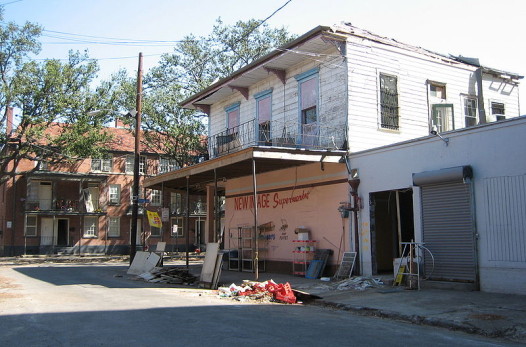
Early Newlmage Supermarket. (Photo: Wiki)
Editors Note: The following is a five-part series called “The Truth about the Big Easy” curated by Parker Kim. This series is in partnership with Via Nola Vie and aims to give transplants and locals a series look at what is happening in our local government.
New Orleans always seems to be being left out of the national conversation. Whenever New Orleans is being mentioned it is either about a natural disaster or a report on the rampant partying going on on Bourbon. Sometimes we forget that there is so much more happening behind the scenes in our city. The floats this year at Krewe De Veux were a clear indication that there is more going on behind the curtain in the New Orleans government. From public education to infrastructure this series of articles will give you a better indication of the current state of this great city. There are so many questions that need to be answered and hopefully, this series of articles opens the curtain to why things are the way they are here maybe just a little bit.
In elementary school, the separation between “deserts” and “desserts” is made clear; in New Orleans, the distinction is not so obvious. That is, of course, when “deserts” refer to food deserts, areas replete with convenience stores, stocked with nutritionally poor food options such as cookies, chips, and instant noodles, and devoid of grocery stores or access to fresh produce within the nearest square mile. From gumbo to oysters to poboys to pralines to snoballs, New Orleans is a city globally renowned for its cuisine. Paradoxically, it is also a city known for its food desserts.
According to the U.S. Hunger Relief Organization, 1 in 7 residents of the Greater New Orleans and Acadiana areas struggle with food insecurity. Among the least food secure areas in New Orleans is the Lower Ninth Ward. In the aftermath of Katrina, the rebuilding of the Lower Ninth Ward has lagged behind that of other areas of the city. To this day, residents of the Lower Nine do not have a grocery store in their neighborhood, and must travel more than a mile to gain access to fresh produce. The Lower Ninth Ward has numerous convenience stores and fast food eateries, but healthy food options are scarce.
The food insecurity crisis manifests in more ways than one. On one hand, a person struggling with food insecurity can look emaciated or hungry from lack of access to food. On the other hand, a person struggling with food insecurity can look overweight, due to lack of access to healthy food options.
Amid the COVID-19 pandemic and despite government efforts to boost SNAP and other safety net programs, food insecurity has increased dramatically. Rising levels of food insecurity highlight holes in America’s economic safety net and a need for further action and efforts to combat this growing problem. A lack of action to combat food insecurity marks a serious injustice against predominantly low-income and BIPOC communities, such as the Lower Ninth Ward, which have been among the hardest hit by the COVID-19 pandemic.
The average New Orleanian is not going to implement a policy change that will solve food insecurity. Nonetheless, some New Orleanians have taken the Crescent City’s food insecurity crisis into their own hands building access to affordable and accessible fresh food options. The upcoming series of articles titled, “Fewer Desserts and Deserts: Fighting Food Insecurity,” curated by Erica Casareno as part of the Newcomb Institute’s Digital Research Internship highlights some local efforts to reduce food insecurity.
Works Cited:
https://lowernine.org/about/
https://www.brookings.edu/blog/up-front/2020/06/23/the-social-safety-net-the-gaps-that-covid-19-spotlights/
https://www.feedingamerica.org/find-your-local-foodbank/second-harvest-food-bank-of-greater-new-orleans-and-acadiana
 NOLAbeings
Multimedia artist Claire Bangser created NOLAbeings as a portrait-based story project that marries...
NOLAbeings
Multimedia artist Claire Bangser created NOLAbeings as a portrait-based story project that marries...
 Data corner: Adobe Suite (create a PDF, social media graphic, presentation, edit a photo and video
Data corner is where you go to work with analytics and top tech skills. It takes on everything from PERL and SQL to Canva and Sprout Social.
Data corner: Adobe Suite (create a PDF, social media graphic, presentation, edit a photo and video
Data corner is where you go to work with analytics and top tech skills. It takes on everything from PERL and SQL to Canva and Sprout Social.

[…] combining technology skillsets, feminist leadership, and digital humanities. You can read the full introduction piece that started this […]
[…] combining technology skillsets, feminist leadership, and digital humanities. You can read the full introduction piece that started this […]